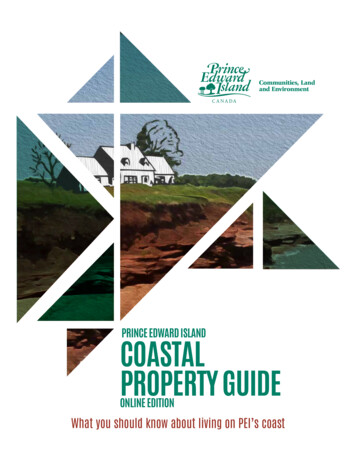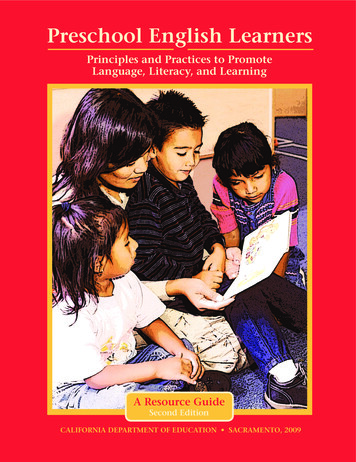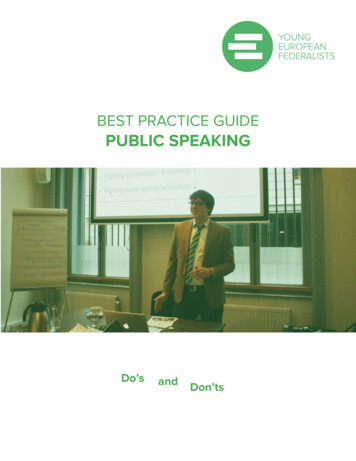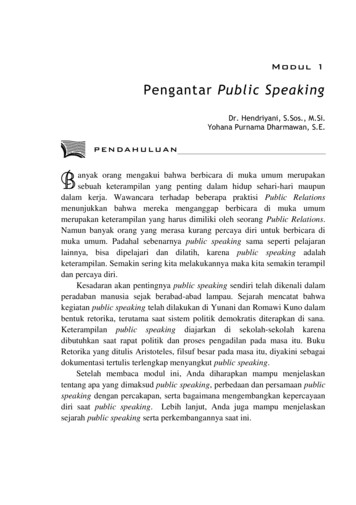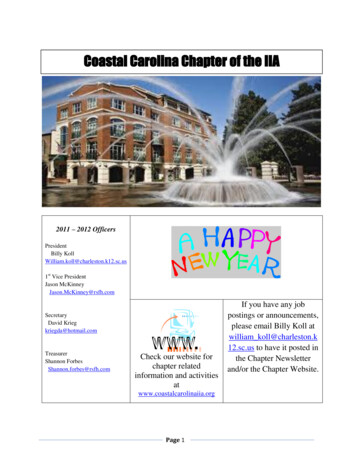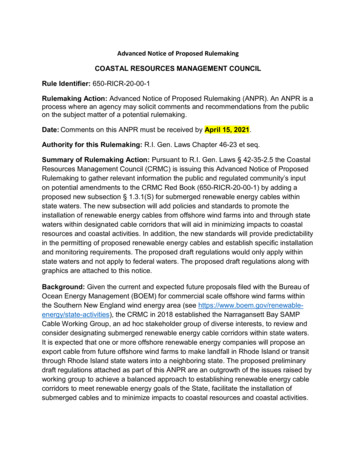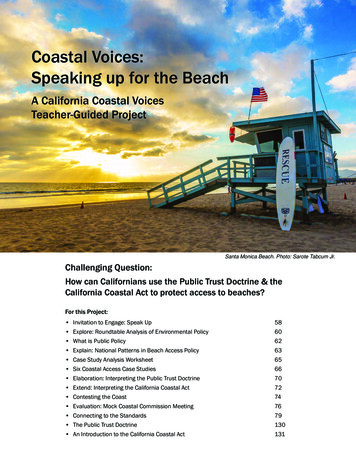
Transcription
Coastal Voices:Speaking up for the BeachA California Coastal VoicesTeacher-Guided ProjectSanta Monica Beach. Photo: Sarote Tabcum Jr.Challenging Question:How can Californians use the Public Trust Doctrine & theCalifornia Coastal Act to protect access to beaches?For this Project: Invitation to Engage: Speak Up 58 Explore: Roundtable Analysis of Environmental Policy60 What is Public Policy 62 Explain: National Patterns in Beach Access Policy63 Case Study Analysis Worksheet 65 Six Coastal Access Case Studies 66 Elaboration: Interpreting the Public Trust Doctrine70 Extend: Interpreting the California Coastal Act72 Contesting the Coast 74 Evaluation: Mock Coastal Commission Meeting76 Connecting to the Standards 79 The Public Trust Doctrine 130 An Introduction to the California Coastal Act131
Coastal Voices: SpeakingUp for the BeachOverviewThe California Coastal Act of 1976 was designed to safeguardand increase Californians’ ability to access the coastline, preventoverdevelopment, and preserve open space and wildlife habitat.Contemplating what is not visible on our coast is the bestpathway to understanding the Coastal Act’s success as a statute:development such as high rise condominiums, golf courses,and multi-lane freeways are limited in number along the 1,270mile mainland coast.Beach access sign in Sea RanchCoastal Voices: Speaking Upfor the Beach contains materialadapted with permission from theConstitutional Rights Foundation’sCivic Action Project.Challenging Questions:What is environmental policy?Who makes policy? How canCalifornians use the Public TrustDoctrine & the California CoastalAct to protect access to beaches?Find images for download, linksto videos, and other resourcesreferred to within this project onthe Coastal Voices Website:www.coastal.ca.gov/coastalvoicesThis unit supports learning inthe following Next GenerationScience Standards PerformanceExpectations:HS-ETS1-3: Evaluate a solutionto a complex real-world problembased on prioritized criteria andtrade-offs that account for a rangeof constraints, including cost,safety, reliability, and aesthetics,as well as possible social, cultural,and environmental impacts.56The Coastal Act directs the state to “enhance and restore theoverall quality of the coastal zone environment and its natural resources” and “maximize public access to and along the coastand maximize public recreation opportunities in the coastal zoneconsistent with sound resource conservation principles and theconstitutionally protected rights of private property owners.” HowCoastal Act policies apply to a particular development must beresolved through planning and permitting processes, consideringthe specific circumstances of the proposal and location.In “Speaking Up for the Beach,” students will study coastal lawand policy in California and elsewhere in the United States,especially as it concerns public access to the coast. They willwrestle with complicated questions about policy andenvironmental responsibility. Students will engage in a mockCalifornia Coastal Commission hearing and create a guide tobeach law in California. This project is different from the othersfound in California Coastal Voices in that it has a strong focus onthe History-Social Science Standards, in addition to the NextGeneration Science Standards. Good science is interwoven with andoften the basis for good environmental policy, so understandingscience concepts and how to apply science to policy decisions isa critical life skill, whether in a professional capacity or as a wellinformed voter.Students will provide evidence of learning by: Developing an Illustrated Citizen’s Guide to California BeachLaw. This graphical guide to the Public Trust Doctrine,California Coastal Act, and California Constitution may bepresented as a comic book, storyboard, or another style thatCalifornia Coastal Voices, by the California Coastal Commission
includes fact-based original drawings and/or writing. Creativeor innovative approaches are encouraged. This document maybe created digitally or on paper depending on technologyresources and preferences.This unit supports learning in thefollowing History-Social ScienceStandards:11.11. 5: Trace the impact of, needfor, and controversies associatedwith environmental conservation,expansion of the national parksystem, and the development ofenvironmental protection laws,with particular attention to theinteraction between environmentalprotection advocates and propertyrights advocates.12.3.2: Explain how civil societymakes it possible for people,individually or in association withothers, to bring their influence tobear on government in ways otherthan voting and elections.12.7.5: Explain how public policy isformed, including the setting of thepublic agenda and implementationof it through regulations andexecutive orders. Participating in a mock California Coastal Commissionmeeting: Students will act as Commission staff, local applicantgroups, presiding commissioners, or other stakeholders. Each student will maintain a notebook that will be reviewed bythe teacher for evidence of changes in student thinking.ActivitiesThese activity descriptions are structured to provide corecontent learning and support the open-ended inquiry processof the project.1. Invitation to Engage: Speak Up2. Explore: Roundtable Analysis of Environmental Policy3. Explain: National Patterns in Beach Access Policy4. Elabore: Interpreting the Public Trust Doctrine5. Extend: Interpreting the California Coastal Act6. Evaluate: Communicating Science, Policy, and Legal Conceptsto Public Audiences: Mock Coastal Commission MeetingThis unit supports learning in theSpeaking and Listening anchorsof the California Common CoreStandards and:Reading Standard 11-12.8:Delineate and evaluate thereasoning in seminal U.S. texts,including the application ofconstitutional principles and use oflegal reasoning and the premises,purposes, and arguments in worksof public advocacy.At the end of this unit you willfind further standards connections,including the three dimensions ofNGSS, California’s EnvironmentalPrinciples and Concepts, and theHistory-Social Science Standardsbroken down by activity.Footprint in Oceano. Photo: Randolph KrauchCoastal Voices: Speaking up for the Beach — A Teacher-Guided Project57
ActivityGuiding Questions: What does taking action look likein our society? Who has the power to makedecisions about how societyuses natural resources?Materials Required: Individual student notebooksDownload from or access on theCoastal Voices Website: “Lower Trestles: A SurflineFeature,” 2011 Surfline video Video of staff report closingcomments at February 2008Coastal Commission Hearingon the Toll Road through SanOnofre State Park (Transcriptalso available) Orange County Register article,“Coastal Commission rejectsFoothill South toll road” Video of public comment from anAcjachemen spokespersonCoastal Voices Invitation to Engage:Speak UpDuring this session students watch, identify, and respond toquestions raised by a state official as he delivers a significantstaff report.EngageWrite the Guiding Questions on the board and instruct students toindividually respond to the questions in their notebooks. Teachercaptures student thinking by writing out ideas on a board or poster.Explore - Public Speaking for a Cause1. Show Surfline video of Trestles to establish a sense of theplace under discussion. Invite students to relax, but tobe thinking of how they would choose to participate inmanagement of this place.2. Pass out copies (or have students view online) the OrangeCounty Register article on the Foothill South toll road. Studentssilently read the article.3. Have students write the following probing questions intheir notebooks:What is being decided during the meeting depicted?What legal or policy issues inform the discussion?How does the speaker support his or her assertions?What evidence is cited to support his or her assertions?Is there any other information you would like to have?What would you do differently?4. Teacher explains that they will twice watch the video of theCalifornia Coastal Commissin Executive Director presenting theclosing comments of the staff report at the hearing on Trestles;the first time without pause, before going through a secondtime to revise understanding and explanations. A transcript isavailable on the Coastal Voices Website to supplement or replacethe video if needed. The teacher may choose to also show one ormore of the videos in the Go Deep box on the following page.5. After watching the video once, teacher leads a discussion ofstudent response to the probing questions.6. During the second viewing, pause as requested by studentsto deepen understanding and allow for revisions toinitial explanations.58California Coastal Voices, by the California Coastal Commission
7. Show the video of public comment from an Acjachemenrepresentative, who spoke at the meeting about the proposedtoll road’s impact on Pahne, a ceremonial site and burialground of the Acjachemen people, the local American Indiantribe. Engage students in a discussion of the probing questionswith respect to this speaker.Reflect on ThinkingIn their notebooks, students individually write a ReflectiveSummary that revises previous answers to the Guiding Questionsof the day. Teachers should encourage students to respond witha cartoon or diagram, in addition to any prose they may deploy.Teacher guides, prompts, and evaluates student thinking.Go Deep.Find links on the Coastal Voices Website for the following: Video testimonials from Acjachemen elders and native activists. Video of the entire Toll Road hearing from the February 6, 2008 California CoastalCommission meeting, including full staff presentations and project applicant statements. Video of the crowd at the Coastal Commission meeting. Surfer Magazine article, “Coastal Commission Commits to Trestles.”Surfer, Trestles. Photo: Christina ViehoeferCoastal Voices: Speaking up for the Beach — A Teacher-Guided Project59
ActivityGuiding Question: What is public policy? What is the connection betweenproblems and policy?Materials Required: Individual student notebooks What is Public Policy reading Sticky notesDownload from or access on theCoastal Voices Website: Carbon Beach image News articles on environmentalpolicy (use the selected articlesor choose others)Coastal Voices Exploration:Roundtable Analysis of EnvironmentalPolicyThis activity is adapted from “Introduction to Public Policy” fromCivic Action Project, Constitutional Rights Foundation. Studentswill conduct academic conversations on the topic of public policyand environmental policy in particular.EngageStudents examine the image of Malibu’s Carbon Beach beforeresponding to the following question in their notebooks: How doesthe built landscape in the image provide evidence of the legal andpolicy environment in force when this place was developed?Explore - Academic Conversation on Public Policy1. Distribute What is Public Policy reading to small groups ofabout four students each. Students read the handout andrespond to the following question individually in theirnotebook: What is public policy?2. In their groups, students conduct an academic conversation onthe following questions:What are some examples of policy? Remember to considerschool, community, and state/federal government levels.Which of these are private policies and which arepublic policies?What are some institutions that create public policyin California?3. Groups post their response on chart paper for classmatesto view. Teacher leads a gallery walk to examine groups’responses to the questions. Students comment with sticky noteson each poster with clarifying questions or observations.4. Read the following definitions of public policy written bypolitical scientists:Clarke E. Cochran, et al.: “Public policy is the outcome ofthe struggle in government over who gets what.”Thomas Dye: Public policy is “Whatever governmentschoose to do or not to do.”B. Guy Peters: “Public policy is the sum of governmentactivities, whether acting directly or through agents, as ithas an influence on the life of citizens.”60California Coastal Voices, by the California Coastal Commission
5. Students respond to the following questions in their journal:Which do you think is the best definition? How would youdefine public policy now?6. Provide each group with one of the articles onenvironmental policy.7. Student groups create a chart listing the individuals or groupsimpacted by their article’s environmental policy in one columnand their respective perception of the policy in the secondcolumn. How do the students think the policy “feels” to eachimpacted group? Post charts and perform a second gallerywalk to compare student insights.Evaluate Explanations and Reflect on ThinkingStudents transition to individual journaling and complete aReflective Summary in their notebooks that responds to theGuiding Questions of the day by making thinking visual. Teachershould encourage students to respond with a cartoon, conceptmap, or diagram, in addition to any prose they may deploy.Teacher guides, prompts, and evaluates student thinking.Students in Seaside. Photo: Lauren KrohmerCoastal Voices: Speaking up for the Beach — A Teacher-Guided Project61
Student ReadingWhat is Public Policy?A starting point for understanding policy is to think ofit as the rules that define how decisions are made in aparticular organizational setting. Policy informs variousdecision makers (teachers, principals, business executives,government officials, presidents) as they govern schools,companies, government agencies, states like California, orentire nations. Typically, policy is written out in the formof a guideline, law, or agency procedure by leaders in theorganization with intent to manage matters of importancewith consistency and integrity. Public policy can be definedas the rules, decisions, and choices made by governmententities that are implemented by government officials atmany levels. Policy is made and implemented by humans, soit can be noble or ignoble, effective or ineffective, powerfulor just plain silly.Most students are aware of public policy, whether they callit that or not. For instance, school policies may come in theform of dress codes, minimum GPAs for sports participation,or attendance requirements. Outside of school, teenagersencounter public policy when seeking driving privileges,health care, or opportunities to participate in government.Students know that a good policy is sensible, adaptive, andfair. Most people of any age can also point to a policy thatthey felt was capricious, arbitrary, or unwise. Questions offair implementation or access to resources are at the heartof many discussions about public policy. This is especiallytrue when the resource is scarce compared to the number ofpeople who would like access.62California Coastal Voices, by the California Coastal Commission
ActivityGuiding Questions: How have policy makersresponded to problems? How can the concept of causeand effect be used tounderstand the implicationsof a given policy?Materials Required: Individual student notebooks Case Study Analysis worksheet Six Coastal Access CaseStudiesCoastal Voices Explanation:National Patterns in Beach AccessPolicyThis activity is adapted from “Introducing Policy Analysis” fromCivic Action Project, Constitutional Rights Foundation. Studentsengage in academic conversation after analyzing coastal accesscase studies.EngageIndividually in their notebooks, students respond to thefollowing quote:“Ruin is the destination towards which all men rush, each pursuinghis own best interest in a society that believes in the freedom of thecommons. Freedom in a commons brings ruin to all.”- Garret Hardin, “The Tragedy of the Commons,” 1968Explore - Academic Conversation on Beach AccessPolicy1. Divide the class into groups of four or six. Distribute Case StudyAnalysis and two Coastal Access Case Studies per group.2. Each group will analyze two case studies chosen by the teacher.Provide half of a group with copies of one case study and theother half of the group with a different case study.GO DEEP.Robert Garcia and EricaFlores Baltodano, with TheCity Project, authored Freethe Beach! Public Access,Equal Justice, and theCalifornia Coast in 2005. Thispaper includes a history ofdiscriminatory beach accessand land use in Californiaand efforts to increase equity.Find the link on the CoastalVoices Website.3. Teacher directs students to read one case study and work withteam members to fill out the Case Study Analysis form. Studentsshare information about the case study with group memberswho worked on the other case study.4. Hold a brief discussion with the whole class to ask clarifyingquestions about the readings.5. Debrief: Students respond to at least three of these prompts:What are some differences and/or similarities you can identifybetween the beach access policies depicted in the case studies?What levels and branches of government are involved in thesepolicies? Explain.If public policy addresses problems, why might some peopleconsider a policy to be a problem? Give an example from oneof the case studies.What did you learn about public policy that you think allcitizens should know?Coastal Voices: Speaking up for the Beach — A Teacher-Guided Project63
Evaluate Explanations and Reflect on ThinkingStudents transition to individual journaling and complete aReflective Summary that responds to the Guiding Questions.Students respond with a cartoon or diagram, in addition to anyprose they may deploy. Teacher guides, prompts, and evaluatesstudent thinking.Torrance County Beach. Photo: Steve Scholl64California Coastal Voices, by the California Coastal Commission
Case Study AnalysisStep One:Read your case study.Step Two:Work with others in your group with the same case study to answer the questions below.1. What is the problem in the case study? (You might identify more than one problem.Analyze one at a time.)2. What is the public policy? (What is government doing or proposing to do aboutthe problem?)3. What group(s) supports the policy? Why? What group(s) opposes it? Why?4. What institution, if any, is making or has made the decision on the policy?5. What level of government is this institution (e.g., local, state, federal, tribal)?6. Is there additional information you wish you had? How might you find it?7. In your opinion, do you believe the policy is a good one? Why or why not?Coastal Voices: Speaking up for the Beach — A Teacher-Guided Project65
Six Coastal Access Case StudiesStudent Reading pg. 1Find links to read more about these case studies on www.coastal.ca.gov/coastalvoicesCape Hatteras National Seashore,North Carolina - Beach DrivingCape Hatteras National Seashore has longbeen a popular location for off-road vehicleuse. Some members of the communitymaintained that this use of the beach anddunes is integral to their local traditions andvital for their economy. Surf fishers claimedthat driving on the beach provides them withthe mobility needed to fish successfully alongthe many miles of shoreline. Environmentalgroups and their members were concernedabout the impact of beach driving on beachspecies and some residents feared for thesafety of children who played on the beachamong the cars and trucks. In 2007, a lawsuitforced the National Park Service to embark ona planning project to regulate beach drivingto protect the Cape’s coastal habitat andvulnerable species.In 2012, the National Park Service issuedtheir plan for off-road vehicles on CapeHatteras. Drivers were required to purchasea permit for their vehicle. Driving at nightwas restricted to certain routes and times ofyear. Certain locations were closed betweenApril 1 and October 31 for nesting birds andturtles, and locations may be closed at othertimes if needed for resource protection. In2015 off-road permits brought in almost 2million to the National Park Service. Somelocal business owners say that limiting offroad vehicle use has reduced the revenue ofbusinesses that depend on those visitors.In 2015, construction continued on a newroad along the dunes to enhance access tomuch of the park while bypassing areas thatare seasonally closed due to bird and turtlenesting. That same year, after continuedprotests that rules were too restrictive, thepark service began holding public meetingsto discuss potential changes to the off-roadvehicle policy, such as increasing the dates66and times when cars are allowed on the beach.Audubon Society representatives called forletting the current policy continue to protectshorebirds and turtles.Greenwich, Connecticut - Private BeachesIn 1995, the town of Greenwich was sued by aman who was prevented from jogging alongthe beach. The town employed guards to keeppeople who did not live in Greenwich fromtraveling on or otherwise using the beach.Lawyers for the town argued that the publictrust doctrine should not apply to their parksbecause in 1919 the state of Connecticut passedan act saying that Greenwich may establishparks, playgrounds, and beaches “for the use ofthe inhabitants of said town.”In 2001 the lawsuit landed with the ConnecticutSupreme Court, which ruled that Greenwich’sbeaches are “public forums” which must beopen to “expressive activity” of any kind,meaning that non-residents must have accessto them.While allowing non-residents to visit thebeach, the City of Greenwich requires that theypurchase a beach pass from a city office duringbusiness hours. As of 2015, a pass for the daycosts 6. Guards are still present to enforce thispolicy. Some residents feel that since they paytaxes for park maintenance, that they shouldbe the only ones to access the beach. Othersthink that there are too many regulations andpeople should have the right to go where theyplease. Some hope that more visitors will helpdiversify and support the businesses in town.Wainiha, Kauai’i, Hawai’i - Defining the BeachIn 2000, a property owner planted and installedirrigation for vegetation in the shoreline area ofhis beach-front lot. In 2002, the owner hired asurveyor to identify the public shoreline. Thisprivate surveyor determined that the human-California Coastal Voices, by the California Coastal Commission
Student Reading pg. 2planted vegetation line, rather than the upperwash of the waves, should serve as the officialshoreline. This determination was agreed toby a state government surveyor. In Hawai’i,the public shoreline is the high water mark.Since this is often identified by a debris line orline of inland vegetation, the surveyors choseto use the more stable line of vegetation.Based on this survey, the property ownersubmitted an application for a new propertyline certification. A local activist contestedthe certification with photos showing waveswashing inland of the vegetation line.The activist filed a lawsuit. The State tookthe position that the property’s shorelinewas consistent with mature vegetation onadjoining properties and that the vegetationwas no longer being irrigated and was stableand well established despite recent winterstorms. The State submitted that “the edge ofvegetation growth is the best evidence of theshoreline in this case, as it shows the result ofthe natural dynamics and interplay betweenthe waves and the line of vegetation over aperiod of time for stability, as against a debrisline which may change from week to weekor from day to day,” and that “the use of theedge of vegetation growth is advantageousover the debris line in that it is practical, easilyidentifiable and stable. “The lawsuit finally reached the Hawai’i StateSupreme Court in 2006. The Court noted thatHawai’i state law defined “shoreline” as,“the upper reaches of the wash of the waves,other than storm or seismic waves, at hightide during the season of the year in whichthe highest wash of the waves occurs, usuallyevidenced by the edge of vegetation growth,or the upper limit of debris left by the washof the waves,” and that it did not state apreference for the vegetation line. The Courtnoted that a previous Supreme Court casefound that “public policy favors extendingto public use and ownership as much ofHawaii’s shoreline as is reasonably possible.”Coastal Voices: Speaking up for the Beach — A Teacher-Guided ProjectThey then stated that “the utilization ofartificially planted vegetation in determiningthe certified shoreline encourages privatelandowners to plant and promote salt-tolerantvegetation to extend their land , which iscontrary to the objectives and policies of [statelaw and] public policy ”Destin, Florida - Beach NourishmentThe law in Florida states that land that isgradually added to the shoreline (called“accretion”) belongs to the beachfrontproperty owner, but a sudden addition of land(called “avulsion”) belongs to the State.The state of Florida has artificially depositedsand on hundreds of its beaches in order tofight erosion. This process is called beachnourishment, and is done in order to protectcoastal property from waves and stormsand to restore the recreation area and habitatof the sandy beach. This is a very expensiveprocess; between 1998 and 2016 Floridaspent 626.6 million, in addition to localgovernment contributions.Beachfront homeowners in Destin, Florida,on the Gulf of Mexico, contended that thegovernment’s plan to deposit sand on theircoast was for the purpose of increasing visitorsin order to support a tourism economy, whichthey felt was not in property owners’ interest.Before a beach nourishment project begins,the government establishes a fixed “erosioncontrol line” which becomes the permanentproperty line. The Public Trust Doctrine holdsthat in Florida the State owns the land upto the mean high tide line. The setting of an“erosion control line” prior to depositing sandon the beach may result in a property line thatis inland from the mean high tide line once thesand is deposited. The Destin homeownersfelt that this would be taking property awayfrom them, by changing their homes fromwaterfront to water-view.67
Student Reading pg. 3The property owners sued the State, and thecase eventually landed at the U.S. SupremeCourt. In its 2009 decision, the Court statedthat “the State as owner of the submergedland adjacent to littoral property has the rightto fill that land, so long as it does not interferewith the rights of the public and of littorallandowners. Second, if an avulsion exposesland seaward of littoral property that hadpreviously been submerged, that land belongsto the State even if it interrupts the littoralowner’s contact with the water. Prior Floridalaw suggests that there is no exception to thisrule when the State causes the avulsion. Thus,Florida allowed the State to fill in its ownseabed, and the resulting sudden exposure ofpreviously submerged land was treated likean avulsion for ownership purposes.” Thenew beach created by beach nourishment ispublic, not private, property.Quinault Indian Nation - Beach PassesThe Quinault Indian Reservation includes 26miles of coastline on the Olympic Peninsulaof Washington State. In 2012, the QuinaultIndian Nation closed their beaches to allexcept enrolled Quinault members. Nonmembers are only allowed if accompanied bya tribal member.There is a lengthy and complex historicalbackdrop for this action. In 1887, the UnitedStates Congress passed the General AllotmentAct, which divided up reservations intoindividual properties. Eventually, tribalmembers were allowed to sell propertyto non-members. Most of the Quinaultreservation land was sold; however, thetribe continues to own all beach lands up tothe ordinary high water mark. Prior to thelate 1960s, the Quinault coast was open tothe public without restriction, and includeda popular surfing spot at Point Grenville.Problems, including litter and graffiti on thebluffs, prompted the Quinault Tribe to limitthis access. As tribes across the country began68asserting their authority over reservation landsduring the American Indian rights movement,in 1969 the Quinault Nation closed GrenvilleBeach to surfing and began requiring a beachpass from the tribal office for any non-tribalmember wanting to visit the beach. Accesswas further restricted in 2012, when the Tribemade the decision to stop issuing beachpasses. According to the Tribe, the access isbeing restricted to preserve functional coastalecosystems.The Washington State Office of the AttorneyGeneral provided the following officialopinion in 1970 regarding rights of coastalaccess:(1) Without regard to any other propertyinterests or rights which the state may have,members of the public have the right to useand enjoy the wet and dry sand areas of theocean beaches of the state of Washingtonby virtue of a long-established customaryuse of those areas. (2) The right of membersof the public to use and enjoy the wet anddry sand areas of the ocean beaches ofWashington by virtue of a long-establishedcustomary use of those areas does notpresently extend to such ocean beach areasas are within the exterior boundaries of theQuinault Indian Reservation.This opinion is based on an 1873 ExecutiveOrder by President Ulysses S. Grant thatwithdrew the reservation’s lands fromthe public domain, reserving them for theexclusive use and occupancy of the Quinaultand other area tribes. The WashingtonAttorney General stated that “If the publichad any rights in the beaches fronting onthe Quinault Reservation on November 4,1873, those rights were extinguished by thatExecutive Order.”Sea Ranch, Sonoma County, California Coastal TrailIn the 1960s, developers purchased a formersheep ranch in rural Sonoma County andCalifornia Coastal Voices, by the California Coastal Commission
Student Reading pg. 4planned a private community of beach homesthat would have closed 10 miles of the coastto the public. As part of the county approvalof the development plan, developers gave toSono
Coastal Voices: Speaking up for the Beach — A Teacher-Guided Project 59 7. Show the video of public comment from an Acjachemen representative, who spoke at the meeting about the proposed
